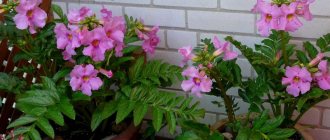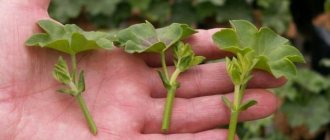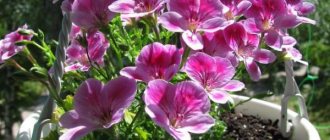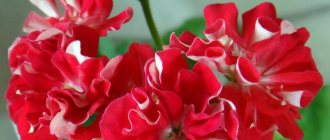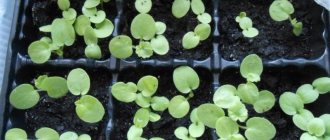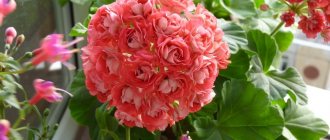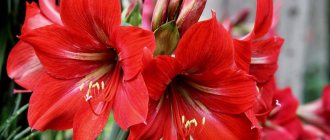Pelargonium rosebud: description
A perennial, light-loving plant that brings aesthetic pleasure to gardeners is pelargonium. Just like geranium, it has a well-developed root system, which is why it was included in the Geraniaceae family. The herbaceous stem is rigid and woody in the lower part of mature plants. It is distinguished by lobed leaves, the cutouts on which occupy no more than 1/3 of the half-width. Fruiting is box-shaped.
There are 3 methods of propagation: dividing bushes, planting seeds or cuttings. Since the birthplace of the culture is South Africa, it is very thermophilic. It needs abundant but rare soil moisture.
Pelargonium rosebud
The plant was first brought to Europe in the 17th century. Already in the 18th century, it began to be propagated and grown as a separate flower species.
According to assumptions, pelargonium appeared as a result of random mutation of cells. Over time, scientists developed a flower resembling a modern plant by crossing different types of flowers. Rosebud pelargonium was officially introduced as a flower species in 1870.
Rosebudna is classified as a variety of zonal terry pelargonium. Externally, the flower bud looks like a half-bloomed rose. Rosebuds are often confused with bush roses. The second name of the flower is Pelargonium rosacea. The only difference between these crops is the shape of the leaves. The inflorescences are represented by small spherical buds.
Ball-shaped buds
Common problems
Pests and parasites. Aphids or whiteflies can settle on a pelargonium bush. Parasites will suck all the juices out of the plant, which will lead to the death of the plant. It is important to treat the bush with insecticides.
Plant disease. Most often, the plant is damaged by gray mold. When mold appears, it is important not to water the flower.
Yellowing and drying of leaves. The plant lacks moisture. Perhaps the water is not getting to the roots. Mulching will help.
The leaves are withered and fall off. Excess moisture. Thinning the plants can help.
Doesn't bloom. This may be due to lack of light and feeding. It is important to ensure the presence of bright, diffused color and regularly apply mineral fertilizers for flowering plants.
The flowers are drying. Perhaps there is a fungus. Treatment with Fitosporin or watering with 5% Bordeaux mixture will help. The presence of rusty, gray spots and white fluff on the leaves may also indicate a fungus. It is important to ensure loosening of the soil for air intake and antifungal treatment.
Bacterial infection. Brown spots will appear on the plant. It is important to replant in another soil and apply fungicides.
Plant characteristics
Pelargonium Apple Blossom Rosebud
Pelargonium is one of the varieties of geranium; it belongs to the rose-type category, which more and more gardeners want to grow at home. The varietal characteristics of shrubs are their compact size and buds that have no aroma. The height of the bushes varies from 60 to 80 cm. The crop is also valued for its unpretentiousness in maintenance.
Something to remember! Preferring rosebud varieties of garden pelargonium, there is a need to renew the plants no later than after 5 years, because over time they lose their varietal characteristics, their splendor decreases, and the formation of inflorescences becomes less intense.
In order for a culture to delight with abundant and lush color, proper maintenance is necessary. First of all, it is necessary to provide moderate moisture to the soil and hide the plant from direct sunlight. If basic recommendations are violated, the leafy part will turn pale, and the bush will lose its lushness and bright aesthetic appearance.
The plant does not tolerate prolonged cold and frost. The best temperature for pelargonium is considered to be 10 degrees above 0. In such conditions, the bushes will be able to survive the winter without damage. It is considered mandatory to update the soil composition annually. You can periodically change your habitat. All this is needed to enrich the soil with various nutrients and microelements, and the soil also needs to be saturated with oxygen.
The best soil mixture for a plant is considered to be a substrate mixture:
- From turf land;
- Peat;
- Coarse sand;
- Perlite;
- Humus.
When replanting plants, you need not only to change the soil, but also to renew the bushes by cutting off old branches. It is also important to apply complex mineral fertilizers several times a season.
Fertilizing with mineral fertilizers
Growing rules
Caring for pelargonium and the process of its propagation at home is not particularly difficult. If your flower specimen is planted in a pot, its watering should be moderate. From time to time, the plant must be shaded so that direct sunlight does not cause burns. To irrigate the substrate, use water at room temperature.
Flower passion.
I love all living plants. I see a highlight in each of them. But my strongest flower passion in recent years has been pelargoniums.
Dear readers, at the moment I have a small but amazingly beautiful collection of unusually blooming pelargoniums. I have “Rosebud” - pelargoniums blooming with roses, Tulip - blooming with tulips, asters, carnations, one variety - peonies. There are several fragrant varieties, with the scent of rose, lemon, wormwood, peach, and apple. And I want to share all this wealth with you.
Terms of sale of pelargoniums 2022
Sales all year round, subject to delivery by a transport company, by bus, I arrange it myself. To the order amount you need to add approximately 400 rubles for transportation and packaging. I don’t send pelargoniums by mail because they don’t arrive well, then they get sick for a long time and, as a rule, they don’t survive.
My email address
Viber and WhatsApp tel.
1. Pelargoniums of the Rosebud series and Rosaceae
Apple Blossom Rosebud is a rosaceous zonal pelargonium. The plant is very large and fast growing. It requires the initial formation of the bush, and then it will show all the beauty and harmony of flowering. Loves very “fat” soil. Last year I fed them with liquid fertilizers for the flowering ones, but this year I just planted them in “humus” in the spring. The variety blooms very profusely, begins early in the spring and, probably, if not pruned in the fall, will bloom into the winter. This photo is fresh from autumn, I published it only because of its good quality, it does not reflect the true beauty of the variety. In summer the hats are much larger and denser. I especially admire roses - large white ones with a green center and pink edging of delicate petals.
2. Pelargoniums of the Tulip series, blooming tulips
Characteristics of species and varieties
Pelargonium Swanland Pink
Several intraspecific groups can grow at home:
- The ampelous type has a creeping stem that does not grow upward. Features cascading foliage. An ivy-shaped plant that hangs down and is used to decorate the garden;
- The zonal species is distinguished by its endurance. Its height reaches 80 cm. The foliage of the species is dark, with a smooth transition to light colors. The fluffiness of the leaves is considered a special feature. The most popular variety that is not planted in open ground. The plant, although hardy, is still demanding;
- The dwarf (miniature) species is distinguished by its compact bushes. There is no need for forming. This variety is preferred to be grown not only in open ground, but also in limited areas. Flowers look very impressive in small pots, since the flowering is abundant and small lush bushes are formed. The plant is relatively picky in its maintenance.
Each of these subspecies has many different varieties, which differ in color, bud shape and content characteristics. The most popular are the rosebud pelargonium variety Red Scarlet, Rosebud supreme, Arctic, Snow and many others.
Rosebud variety Red Scarlet
It is necessary to consider the description of popular varieties:
- Vectis rosebud is a small-looking, mature bush that looks attractive. A good option for shaping. The main advantage is the abundant, long-lasting flowering. The bud is bright red. The inside of flower petals is darker than the outside;
- Pelargonium Rosebud Supreme - blooms with bright crimson, thick, double buds. The bud turned inside out has a different color scheme. The underside of the bud is white, which looks unusual. The bushes are straight and strong. The inflorescences of Rosebud Supreme Pelargonium are dense, bloom for a long time, and with proper care, flowering can be extended throughout the year;
- Pink rambler is one of the popular varieties. A bright and lush bush with corrugated leaves. Flower bud of bright pink color with red impurities. The front side is lighter;
- Margaretha pelargonium is a variety of royal geraniums used exclusively for decorative purposes. The blooms are arranged in several rows, which in appearance resemble small bouquets of unopened roses. The foliage has curly outlines resembling a border. The height depends on the location and can reach 80 centimeters;
- Red pelargonium Rosebud red is a plant with red double inflorescences. It has long and abundant flowering. The inflorescences themselves are thick, lush, dense. There is no need to form bushes. Optimal temperature for growing: 25 degrees in summer, from 15 to 20 degrees in winter. The flower is grown indoors;
- Pelargonium baby rosebud is a compact plant. The buds are red, with a faint crimson tint, white in the middle. The leaves are inconspicuous, of normal shape;
- Beverly park pelargonium is distinguished by large flower buds, double, apricot color. At the edges the color of the inflorescences is lighter. The leaves are green, darkening towards the center.
On a note. Regardless of the chosen species and variety: Pelargonium Rosebud Supreme, Vectis rosebud or Pelargonium Baby Rosebud, they need proper care, which will extend the flowering period.
Varieties
Pink pelargonium blooms very beautifully, not inferior even to the rose itself. But if you want to include a similar specimen in your home collection, you should take a closer look at studying its most popular varieties. There are many of them, and they all have their merits. Let's find out which varieties of rosebud pelargonium are worth having in your home, and, if desired, in your personal plot.
Vectis rosebud
This shrub looks miniature, even when mature. You can safely grow it even if you are just getting acquainted with this group of plants. The Vectis rosebud variety does not need to be shaped. Among its key advantages is a long flowering phase. The mini-buds have a bright red hue, but the outer side of the petals in this case is slightly lighter.
Pink rambler
The geranium variety called Pink Rambler is considered one of the most popular in this category. If you want to have a very lush shrub with decorative corrugated leaves in your home, you should definitely think about planting this flower. The buds of this flower specimen are bright pink, and the shape of the petals is quite unusual. In this case, the front side of the petal is painted in a lighter shade.
Bornholm
Those flower growers who decide to root this attractive specimen at home should remember that its buds open very, very slowly. However, the not too high growth rate is more than compensated by the beautiful and rather lush flowering. The buds have a bright red hue, and their texture resembles satin.
However, when this happens, the petals do not fall off for a long time. Do not underestimate the foliage of this green specimen. They have a rich green hue, and each leaf plate has a mesh pattern.
Vit rosen
If Red Pelargonium or Pink Rosebud are not the only specimens you intend to include in your home collection, you should consider purchasing a Vit rosen flower. What is primarily remarkable about this variety is its buds with soft white petals, which have a muted green tone at the base. The flowers are formed double.
Arctic snow
If the previous flower specimen had white petals with a greenish tint, in this case the geranium buds have a pure white color. However, there is a key difference: the petals of such a plant are not double, but star-shaped.
Such a specimen will look very unusual. Moreover, some representatives of this variety are additionally covered with light stripes, which beautifully set off the base color.
Black pearl
This flower specimen belongs to the group of zonal plants. Its buds have a rich crimson hue. Immediately after the buds open, this pelargonium’s main color is burgundy, but over time it “fades” and becomes crimson. Another key characteristic of this variety is that it is considered fastidious in care (just look at the process of forming a shrub). However, the result will be worth the effort.
Features of planting and care
Pelargonium Sutarves Klara San
If we compare all types of plants, pelargonium is finicky. It should only be planted in pots. It is necessary to protect the flower from the influence of winds, rain and temperature changes. There should be regular air circulation in the room, without drafts. The plant needs full lighting, so it needs to be turned around periodically. With the arrival of the warm season, the pots can be taken out into the fresh air. Once a year you need to change the soil composition. Pelargonium should be protected from direct sunlight.
Reproduction methods
Propagation can occur by using seed material or using cuttings. In the first case, the new shoots will not inherit the parental qualities, but this will not create obstacles to growing healthy plants.
Seeds - seedlings and their preparation
First, the seeds are placed in miniature greenhouses, first moistened in a growth stimulator. They need to be well ventilated, illuminated and moistened. The seeds are placed at a distance of 5 cm from each other.
Propagation by cuttings
To obtain new plants, you can use seeds or cuttings. In the first case, new plants may not inherit their parental properties.
When using cuttings, there is a risk that they will not be able to take root and will rot. However, if everything is done in compliance with the appropriate rules, then the process of propagation of these plants will occur without any problems.
Rooting cuttings
To prepare cuttings, cut a branch from the mother plant that has not yet become completely woody. It is necessary that 3-5 internodes can be distinguished on it. If the cutting is too grassy, this will lead to its rotting.
The soil for planting is light and loose. It is recommended to use a mixture of soil and peat for this purpose. Before planting them in the ground, they need to dry for an hour.
When planting in the ground, you need to bury it in the ground so that one internode is closed.
Watering during the first day should be insignificant. If you germinate cuttings in transparent glasses, this makes it possible to observe how their roots grow.
Landing in the ground
If at least 5 leaves appear, the plants are transplanted into pots. After their length reaches 20 cm, they are pinched.
Major diseases
Like all plants, pelargonium can get sick. Plants may also suffer from pest attacks. Problems encountered when growing pelargoniums:
- Wilted leaves are a sign of high temperature and insufficient watering;
- Changes in foliage color - excess moisture and insufficient lighting;
- Spots on leaves are a sign of viral infections;
- Drying inflorescences are a sign of fungus;
- Gray rot.
Any problem can be eliminated by treating with chemicals or by ensuring proper maintenance conditions.
Proper pruning
Reference
Pruning should be done with extreme caution - the flower does not really like it. In order not to cause damage to the plant during this work, you need to know simple rules:
In order not to cause damage to the plant during this work, you need to know simple rules:
- The first pruning should be done only after the final rooting of Denise’s pelargonium.
- When pruning, use a sharp and disinfected tool.
- Pinching should be done only after the growth of young shoots - in this case, lateral branching occurs faster.
In the autumn, after flowering, it is necessary to remove those branches that are sick, too weak or withered.


